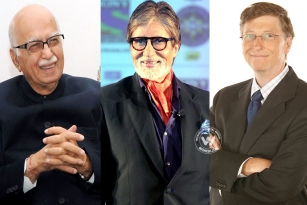
In the history of mankind December 13 2011 was one of the most memorable day as two physicists Fabiola Gianotti and Guido Tonelli disclosed elementary particleHigg’s Boson the fragment of hundreds of trillions of proton collisions inside the Large Hadron Collider at CERN the European particle physics laboratory near Geneva, Switzerland.
One of the primary goals in modern physics is to answer the question, “What is the universe made of?” Often that question boils down to “What is matter and what holds it together?” We find traces of this quest in almost all civilisations such as Indian, Greek, Egyptian, Babylonian, etc. However, the most scientific answer was given by John Dalton from England in the middle of the 18th century. According to Dalton’s atomic theory, this universe is made up of very small indivisible infinite numbers of atoms. The physical existence of the atom was convincingly proved later by Albert Einstein in his famous paper on Brownian motion, zigzag, describing the motion of atoms in a liquid.
J J Thompson from Cambridge University, after painstaking efforts for several years, invented negatively charged electrons in 1897 and demonstrated that an atom can be further divided and it’s not the smallest entity of this universe. This sent ripples across the entire scientific community. Under the leadership of Ernst Rutherford in Cambridge University, a series of experiments were planned in search of an atomic structure.
Rutherford later proved the existence of positively charged protons inside the atoms and his colleague James Chadwick discovered charge-less neutrons and the old theory of the indivisible atom collapsed. The new theory on atomic structure was formulated by Rutherford in collaboration with Neils Bohr from Denmark. According to Bohr-Rutherford’s model, an atom consists of positively-charged nucleus made of protons and neutrons. Electrons which are equal in number to protons revolve around the nucleus in various orbits. This atom is extremely stable due to electromagnetic force between positively-charged nucleus and negatively-charged electrons.
However this relief did not last long. In the 60s, scientists started suspecting that protons and neutrons were divisible too. Hidden inside the nucleus of an atom, there is an entire world of subatomic particles. They are governed by the laws of physics that display extreme complexity. These particles are called fundamental elementary particles. To reveal the existence of these particles, a huge particle accelerator and super colliders were built. These machines are extraordinarily expensive. The particle accelerator at CERN is about 22 km long with one end in Switzerland and the other in France.
In the ‘60s and ‘70s, hundreds of such subatomic elementary particles like neutrinos, keons, pions, mesons, leptons, W plus, W minus, etc were detected in experiments carried out in a supercollider. They had different properties, masses and speeds. Most of these particles were short-lived and disappeared within a fraction of a second after their birth. A chaotic atmosphere was created in the field of atomic research as the classification and further study of these subatomic particles was very tedious. During this period, a New York-born scientist Murray Gell Man proposed another elementary particle called the quark. This created greater confusion. However, he suggested some effective methods of classifying these large numbers of elementary particles.
Murray Gel Man with the help of some other scientists developed a theory called ‘standard theory’. This theory was developed to explain the basic constituents of the matter and laws those govern the universe. According to this standard theory, all the fundamental elementary particles are classified in three groups; leptons (particles with low mass), mesons (particles with medium mass) and baryons (particles with heavy mass). Standard theory says some particles like photons, gluons, and neutrinos are even massless. One of the hypotheses of this theory is that all forces in the universe can be reduced to four basic forces namely gravitational force, electromagnetic force, strong nuclear force and weak nuclear force. The beauty of the standard theory lies in the fact that it also postulated the existence of some elementary
particles not known then.
Most of the particles predicted by the Standard Model have been now observed at the super collider. The exception is the Higgs boson. This particle was first proposed by Peter Higgs, a scientist from Edinburgh University in 1964. It is expected that this particle would follow the laws developed by great Indian physicist ‘Satyendranath Bose’ with Albert Einstein popularly known as Bose-Einstein statistics. Thus this particle was christened Higgs boson. However, the standard theory was questioned seriously as experiments carried out in Japan concluded that neutrinos are not mass less as predicted by standard theory but has definite mass.
Higgs boson is crucial in understanding the origin of mass. Shortly after the big bang, it is thought that many particles had no mass, but became heavy later. Higg’s boson is a particle which endows mass to other elementary particles. Thus decades of work have been devoted to finding what this particle popularly referred to as the ‘God particle’ is.
It was on December 13 that scientists from CERN could narrow down the region where the Higg’s boson is most likely to be. To hunt for the Higg’s boson, physicists at the LHC sift through showers of subatomic debris that spew out when protons collide in the machine at a velocity close to that of light velocity. Most of the energy released in these microscopic fireballs is converted into well known particles that are identified by the collider's giant detectors. Occasionally the collisions might create a Higgs boson, but it is expected that it would disintegrate immediately into more familiar particles. Higgs boson is very important to the physics community. It can throw some light on 96 per cent invisible dark matter present in the universe.
This discovery is one of the best in advanced science since last 100 years and confirms these particles (Higgs Boson) gain mass and contradicts the standard theory which states only that visible matter gains mass but fails in reveling this mystery of dark matter.This new discovery opened doors in disclosing the mystery of universe.























